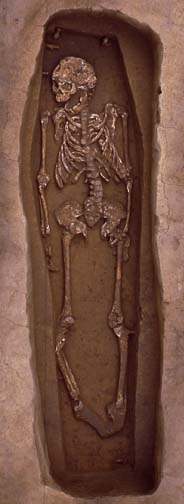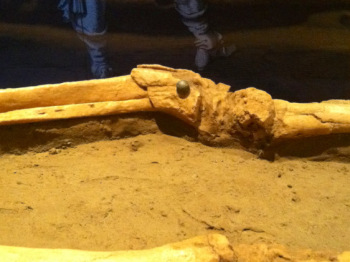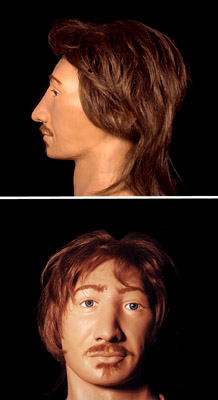Forensic Case Files: American Colonies’ First Murder Victim, Circa 1624
/ The skeleton was found in 1996 by the Jamestown Rediscovery Archaeological Project team on Jamestown Island, Virginia. Unlike the majority of the settlers’ graves located in the cemetery within the James Fort, the man was discovered under an old roadbed near one other grave close to the southern palisade and the site of the barracks. Soil staining and the remnants of rusted iron nails indicate that he was buried in six-sided, flat-lidded wood coffin. His naked body was originally wrapped in a shroud that is long gone—its presence now only marked by green stains left on the skull and right shin from two brass straight pins used to secure it.
The skeleton was found in 1996 by the Jamestown Rediscovery Archaeological Project team on Jamestown Island, Virginia. Unlike the majority of the settlers’ graves located in the cemetery within the James Fort, the man was discovered under an old roadbed near one other grave close to the southern palisade and the site of the barracks. Soil staining and the remnants of rusted iron nails indicate that he was buried in six-sided, flat-lidded wood coffin. His naked body was originally wrapped in a shroud that is long gone—its presence now only marked by green stains left on the skull and right shin from two brass straight pins used to secure it.
Forensic anthropologists could tell much about the man from his remains. He was tall for the time at nearly 5’9”. He had a slight build, but significant muscle attachment points on the skeleton indicated a strong upper body. He was between the ages of 18 – 20 and showed no sign of disease. His cause of death was equally clear: His right leg was broken and twisted just below the knee, with no signs of healing or bone remodeling. A lead ball and shards of lead shot were embedded in and around the bone.

Forensic anthropologist Dr. Doug Owsley (who has been involved with cases such as the lost Union Solider at Antietam, the murder of a Jamestown colonial servant, and evidence of cannibalism at James Fort) determined that the lead ball hit the leg with such force that it shattered the bone and tore all the soft tissue, twisting the leg 180o. The wound was fatal, likely rupturing the popliteal artery, and the victim bled out within minutes.
The skull was badly crushed from centuries of pressure from above, but was painstakingly reconstructed by forensic anthropologist Dr. David Hunt, allowing forensic artist Sharon Long to create a 3D reconstruction of the victim:


Up to now, the man’s identity has been a mystery. But recent research has revealed that he was most likely George Harrison, who met his end following a duel with Richard Stephens. The fatal injury shows that the bullet struck Mr. Harrison’s leg to the side of the knee. At the time, a typical dueling pose was to stand sideways with your arm and flinklock pistol extended towards your opponant. But the injury is in an unusual location as most duellers would aim for the upper body, a larger target with more vital organs. So was Mr. Stephens a bad shot, or was he aiming to cripple?
There is also some question about the type of ammunition used in the duel. What killed Mr. Harrison was a ‘combat round’ that contained a large main bullet as well as smaller lead shot. Duelling ammunition of the time typically only involved a single lead ball. It is believed that a combat round of this type would not be used in a duel by an honest and honourable combatant.
Richard Stephens, who survived the duel and later went into politics, died in 1636.
Photo credit: Jamestown Rediscovery



 87.5%
87.5%